CFP: Scientific illustrations - University of Burgundy - 2012-2015
Scientific illustrations - call for participants and papers
The Centre de Recherches Texte/Image/Langage at the University of Burgundy (Language and
Communication) is planning a three-to-four-year programme of seminars on illustrations in
science. The programme, scheduled from 2012 to 2015, will focus on exploring as
exhaustively as possible the relations between scientific texts and their illustrations. Our aim is
to reflect on the theories underlying these relations, in order to clearly define both
the criteria of scientific illustrations and the part played by illustrations in scientific
progress. By its very nature, the subject inevitably presupposes a post-fifteenth century
Western bias, but the programme is not exclusive and is open to alternative approaches.
The programme involves the study of scientific development, alongside the development of
illustrative techniques. Studies focusing on specific disciplines (illustrations in
medicine, physics, biology, etc) are as welcome as those with a chronological approach (
illustrations during the Renaissance, the Enlightenment, etc), often involving the crossing of
boundaries into other genres of images.
The seminars will be organised in group sessions devoted to the following themes (the
list is provisional and may be extended):
* the objectives of scientific illustrations. To what extent does the illustration's
educational function in the dissemination and popularisation of science conflict with, or
alternatively, complement, its epistemic role and its value in furthering scientific
knowledge?
* scientists, illustrators, and scientist-illustrators. Some scientists illustrate their
work themselves; others use professional illustrators with no scientific training. Is the
distinction significant? Papers focusing on the latest developments in the techniques of
scientific illustration will be particularly welcome, as will contributions from
illustrators themselves.
* evaluating scientific illustration. Do some sciences defy illustration? How do you
illustrate an experiment? What does the reader of a scientific text expect from the
illustrations? Can the illustration be more informative than the text it illustrates?
Among the many questions raised by this subject, some jump to mind with a particular
immediacy: what happens when the microscope and telescope replace the naked eye? How have
anatomical plates and terrestrial cartography evolved as science has advanced? To what extent
do so-called "scientifically objective" images reflect the ideology, prejudices and
cultural fixations of a particular age?
The exchanges between historians of science and specialists of the image on all these
topics should, we hope, be productive and profitable. Most of the seminars will take place
on the University Campus in Dijon, France (exceptionally special locations may be involved)
. A publication incorporating the contributions is planned. The first seminar is scheduled
provisionally for the end of 2011 or the beginning of 2012. The working languages will be
English and French.
For further information and proposals for papers, contact project coordinator
Marie-Odile Bernez at marie-odile.bernez@u-bourgogne.fr.

